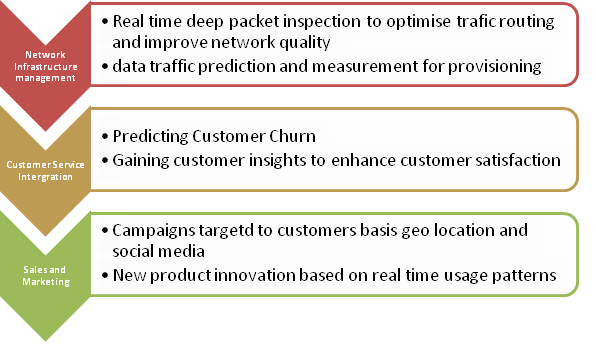Telecommunications is complex business. As users we are mostly faced with one question- how to get the best deal out of the many telecom players in the market? But as an analyst in a Telecom company one may be faced with any one or more of the following question –
- How many Network Towers should be installed in a particular area to meet the rising demand given the rise in population, rising need of data connectivity and competition?
- What should be the optimum call rate to maintain revenue margins in the wake of severe price competition among Telecos?
- How do we track call data to minimize frauds?
- How do we induce higher and broader use of Data by non users for increasing revenue?
Sources of Big data in telecommunications include phone calls, emails, messages, transactions, log data, social media usage, geo-spatial information, downloads, digital media, social media, data from sensors, and more.
Broadly there are 3 types of Big Data generated in any telecommunication business:
- Call-Details data
- Network Data
- Customer Data
These will include phone calls, emails, messages, transactions, log data, social media usage, geo-spatial information, downloads, digital media, social media, data from sensors, and more.
The use of Big Data Analytics in telecommunications is used to create real time analysis of customer preferences and network efficiency. Use of Advance Analytics directly impacts:
- Customer experience
- Data driven efficiency
- Data driven growth
Broadly use of Data Science in Telecom can be categorized as under:
According to Mind Commerce, big data can be used to improve business processes and provide insights into a telecom company’s customer base in near real-time, using both structured and unstructured data. Some key areas include:
- Monitoring network traffic to improve service
- Analyzing call data records to identify fraudulent activity
- Customizing call plans based on usage patterns
- Using data from social networks to optimize marketing campaigns
Telecom companies now wish to move beyond traditional descriptive and exploratory analytics, which was mainly used for postmortem of business decisions, to advanced analytics and machine learning driven automated decision making. These new big data analytics technology platforms are improving personalization at a transformational scale by allowing telecom companies to manage customer expectations in the very moment of truths.
Read our blog for details of how other industries use Analytics.
References:

